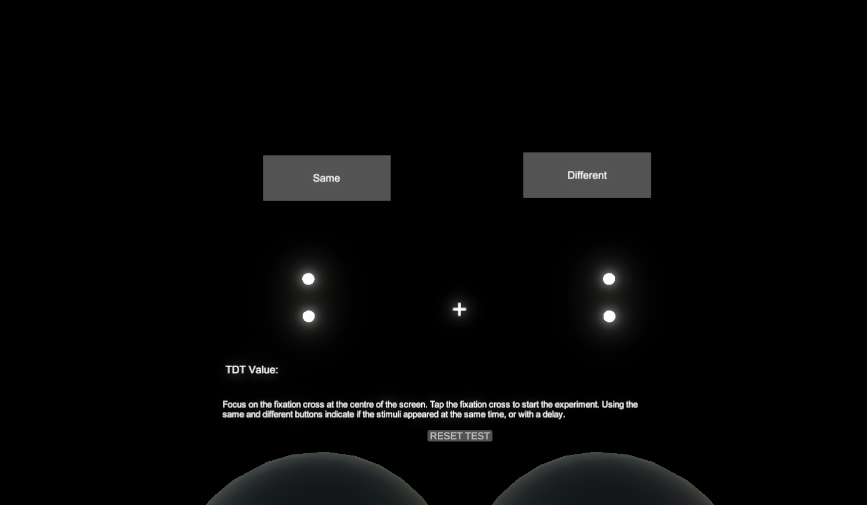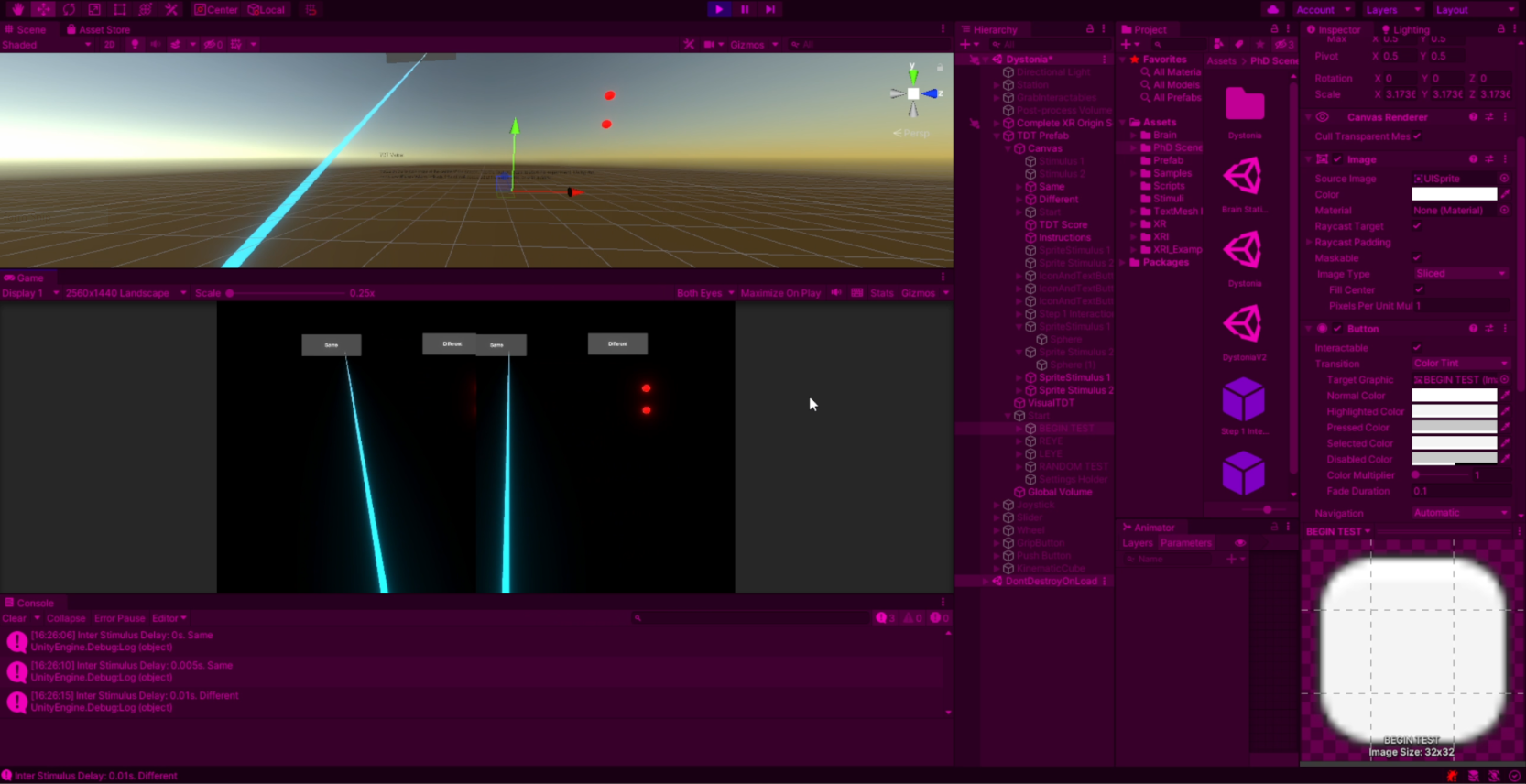Category: Dystonia: Pathophysiology, Imaging
Objective: To develop a Virtual Reality (VR) application to test temporal discrimination thresholds in cervical dystonia patients within an outpatient environment.
Background: Temporal discrimination threshold (TDT) is a measure of stimuli signal processing. It represents the time interval required between stimuli for recognition of independent events [1]. Elevated TDT measures are correlated to delayed signal processing. For instance, there is a demonstrated age-related effect, where TDT increases with age [2]. Further, TDT has been linked with movement-based disorders that involve the basal ganglia, such as dystonia [1]. Ongoing research into Dystonia pathophysiology indicated an abnormal sensory processing hypothesis involving the Superior Colliculus. Research has demonstrated abnormal and prolonged TDT in dystonia patients [3]. Such findings outline the potential for TDT as a research metric into disease pathophysiology and as a diagnostic tool.
Method: We have continued research on developing a robust process for an easily distributable environment for visual TDT measurement. The current study progresses this further into a VR-based Android environment [Figure 1]. The benefits of this approach allow for more stringent parameter control, including screen resolution, stimuli placement, and luminance control. This allows for maintaining internal validity between testing participants while allowing portability.
The environment is coded using Unity but optimised for the Oculus Meta Quest 3 Headset [Figure 2]. The visual TDT task includes the presentation of two visual stimuli, lateralised to 7 visual degrees from fixation either to the left or right. TDT is measured via a stepwise approach with stimuli presented in increments of 5 msec, with the TDT score taken when the subject indicates asynchronous stimuli presentation. These experimental parameters have been chosen to mimic the existing gold standard headset TDT [4]. A randomised presentation of stimuli was also implemented.
Results: Preliminary data from a healthy, convenient sample of 10 subjects demonstrated consistency with known TDT effects, showing shorter duration TDT scores in younger versus older age cohorts and also in younger female versus male cohorts.
Conclusion: With the new VR approach validated to the original headset TDT gold standard, the current TDT testing in a clinical environment allows for a wider range of patient and relative testing.
TDT Virtual Testing Environment.
Program Setup vis Unity.
References: [1]. Beck, Rebecca B., Eavan M. McGovern, John S. Butler, Dorina Birsanu, Brendan Quinlivan, Ines Beiser, Shruti Narasimham, Sean O’Riordan, Michael Hutchinson, and Richard B. Reilly. “Measurement & analysis of the temporal discrimination threshold applied to cervical dystonia.” JoVE (Journal of Visualized Experiments) 131 (2018): e56310.
[2]. Ramos, Vesper Fe Marie Llaneza, Alina Esquenazi, Monica Anne Faye Villegas, Tianxia Wu, and Mark Hallett. “Temporal discrimination threshold with healthy aging.” Neurobiology of aging 43 (2016): 174-179.
[3]. Kimmich, Okka, Anna Molloy, Robert Whelan, Laura Williams, David Bradley, Joshua Balsters, Fiona Molloy et al. “Temporal discrimination, a cervical dystonia endophenotype: penetrance and functional correlates.” Movement Disorders 29, no. 6 (2014): 804-811.
[4]. Molloy, Anna, Okka Kimmich, Laura Williams, Brendan Quinlivan, Adriana Dabacan, Aisling Fanning, John S. Butler, Sean O’Riordan, Richard B. Reilly, and Michael Hutchinson. “A headset method for measuring the visual temporal discrimination threshold in cervical dystonia.” Tremor and Other Hyperkinetic Movements 4 (2014).
To cite this abstract in AMA style:
SR. Bostan, B. Lim, C. Fearon, R. Reilly. Visual Temporal Discrimination Threshold using a Virtual Reality Paradigm in Cervical Dystonia [abstract]. Mov Disord. 2024; 39 (suppl 1). https://www.mdsabstracts.org/abstract/visual-temporal-discrimination-threshold-using-a-virtual-reality-paradigm-in-cervical-dystonia/. Accessed December 4, 2025.« Back to 2024 International Congress
MDS Abstracts - https://www.mdsabstracts.org/abstract/visual-temporal-discrimination-threshold-using-a-virtual-reality-paradigm-in-cervical-dystonia/


